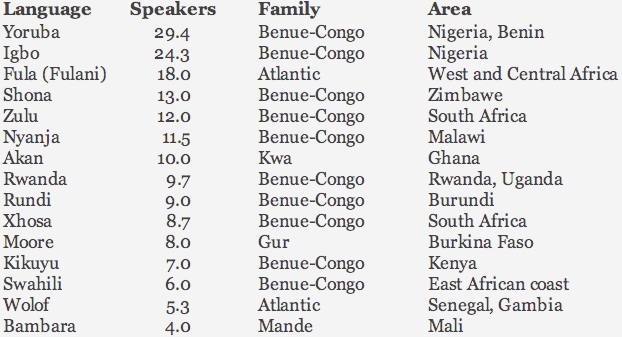An insatiable appetite for ancient and modern tongues


Overview. Considering the number of its speakers and languages as well as its wide geographical spread, Niger-Congo is by far the largest of the four major phyla of Africa (the other three are Nilo-Saharan, Afro-Asiatic and Khoisan). It comprises more than 1000 languages and is spoken by about 60 % of the population of Africa.
Classification and Distribution. Niger-Congo predominates in sub-Saharan Africa extending from Senegal in the west to Kenya in the east, and south up to South Africa. Though its classification is not settled, it is generally agreed that Niger-Congo encompasses nine families (or sub-families): Atlantic, Mande, Kru, Gur (Voltaic), Kwa, Adamawa-Ubangi, Benue-Congo (which includes the Bantu languages), Ijoid and Kordofanian. There is disagreement about the classification of one major language: Dogon.
Map of Niger-Congo languages (click to enlarge it)
a) Atlantic, the westernmost branch of the Niger-Congo, is spoken along the Atlantic Coast. It includes, among others, Wolof and Fula which extends inland into de savannas up to Sudan.
b) The best known Mande languages, spoken in western Africa, are Bambara, Dyula, Malinke, Mandinka (Mande), West and East Maninkakan.
c) Kru languages are spoken in the forest regions of southern Liberia and south-west Ivory Coast.
d) The largest of the Gur or Voltaic languages, spoken mainly in Burkina Faso, Ivory Coast, Ghana, Togo and Benin, is Moore.
e) The Kwa family, in the southern regions of Ivory Coast, Ghana, Togo and Benin, includes Baule, Akan and Ewe.
f) Adamawa-Ubangi, spoken in Cameroon, southern Chad and the Central African Republic, includes Gbaya, Banda and Zande.
g) Benue-Congo is, by far, the largest family. It is divided between Non-Bantoid and Bantoid, the latter itself divided into the Non-Bantu languages of central Cameroon and eastern Nigeria, and the Bantu languages that spread across the entire southern half of the continent. The main Non-Bantoid languages are the Nigerian Yoruba and Igbo. Of the Bantu languages the most numerous are Swahili, Rwanda, Shona and Zulu.
h) Ijoid, located in the Niger Delta, includes Defaka and the Ijo cluster.
i) Kordofanian languages are geographically separated from the other Niger-Congo languages and confined to the mountains of central Sudan.
j) Dogon is spoken in Mali.
Speakers. More than 600 million people speak a Niger-Congo language, 330 million of which speak one of the Bantu group. For each of the nine families and the unclassified Dogon the approximate number of speakers (in millions) is:
Benue-Congo
Atlantic
Kwa
Mande
Gur
Adamawa-Ubangi
Kru
Ijoid
Dogon
Kordofanian
500.0
30.0
25.0
25.0
24.0
12.0
3.0
2.5
0.6
0.5
Note: 2/3 of Benue-Congo speakers, speak a Bantu language.
Among the individual languages the most popular are (in millions):

Note: The total number of Swahili speakers, including first and second language speakers amount to 50-100 million.
Oldest Documents. The earliest attestation of Niger-Congo words are found in Portuguese documents of the 16th century and in a work of an Italian mathematician from the same period. The first book in a Niger-Congo language was a catechism in Kongo, a Bantu language, published in 1624. Kongo was also the choice for the first grammar of the phylum, written in 1659.
SHARED FEATURES
-
✦ Phonology
-
Vowel Harmony. The northern group of the Atlantic branch and the non-Bantu languages of Benue-Congo exhibit ATR vowel harmony. In it, there is a contrast between vowels pronounced with an advanced tongue root (+ATR) and a retracted tongue root (-ATR): only vowels from the +ATR set or from the -ATR set appear in the same morpheme.
-
Tonal Systems. Most Niger-Congo languages have tones though some of the most important, like Swahili and Fula, do not. Usually, they have two or three tones but in some languages four or five. Tones serve to make lexical and grammatical distinctions.
-
✦ Morphology
-
Noun Classes
-
-The system of noun classes is probably the characteristic most widely found in Niger-Congo languages (though Mande doesn't have them). Nouns are grouped in different classes, marked by prefixes, suffixes or both. All members of a given class share the same affix.
-
-Most noun class systems have an accompanying concord system: other elements of the noun phrase (such as determiners, adjectives, or quantifiers), and frequently the verbs as well, are marked by an affix selected according to the class of the noun.
-
-The number of noun classes varies greatly from language to language. For instance, Proto-Bantu had 19 noun classes, Atlantic languages have from 3 to 25, and Gur languages usually 11.
-
-Some classes are semantic (humans, animals, plants, parts of the body), others are based on grammatical categories (infinitives, locatives, diminutives) but many are heterogeneous.
-
Serial Verbs. Serial verb constructions are frequent in Niger-Congo. In them, two or more verbs, having the same subject, tense and mood, stand next to each other without a conjunction.
-
© 2013 Alejandro Gutman and Beatriz Avanzati
Further Reading
-
-The Languages of Africa. J. H. Greenberg. Indiana University Press (1963).
-
-A Linguistic Geography of Africa. B. Heine & D. Nurse. Cambridge University Press (2008).
-
-The Niger-Congo Languages: A Classification and Description of Africa’s Largest Language Family. J.T. Bendor-Samuel & R. L. Hartell (eds). Rowman & Littlefield (1989).
-
-African Language Structures. W. E. Welmers. University of California Press (1973).
-
-A Phonetic Study of West African Languages. P. Ladefoged. Cambridge University Press (1968).
Niger-Congo Languages

Address comments and questions to: gutman37@yahoo.com
MAIN LANGUAGE FAMILIES
LANGUAGE AREAS
Languages of Ethiopia & Eritrea
LANGUAGES by COUNTRY
LANGUAGE MAPS
-
• America
-
• Asia
-
Countries & Regions
-
-
Families
-
• Europe
-
• Oceania
